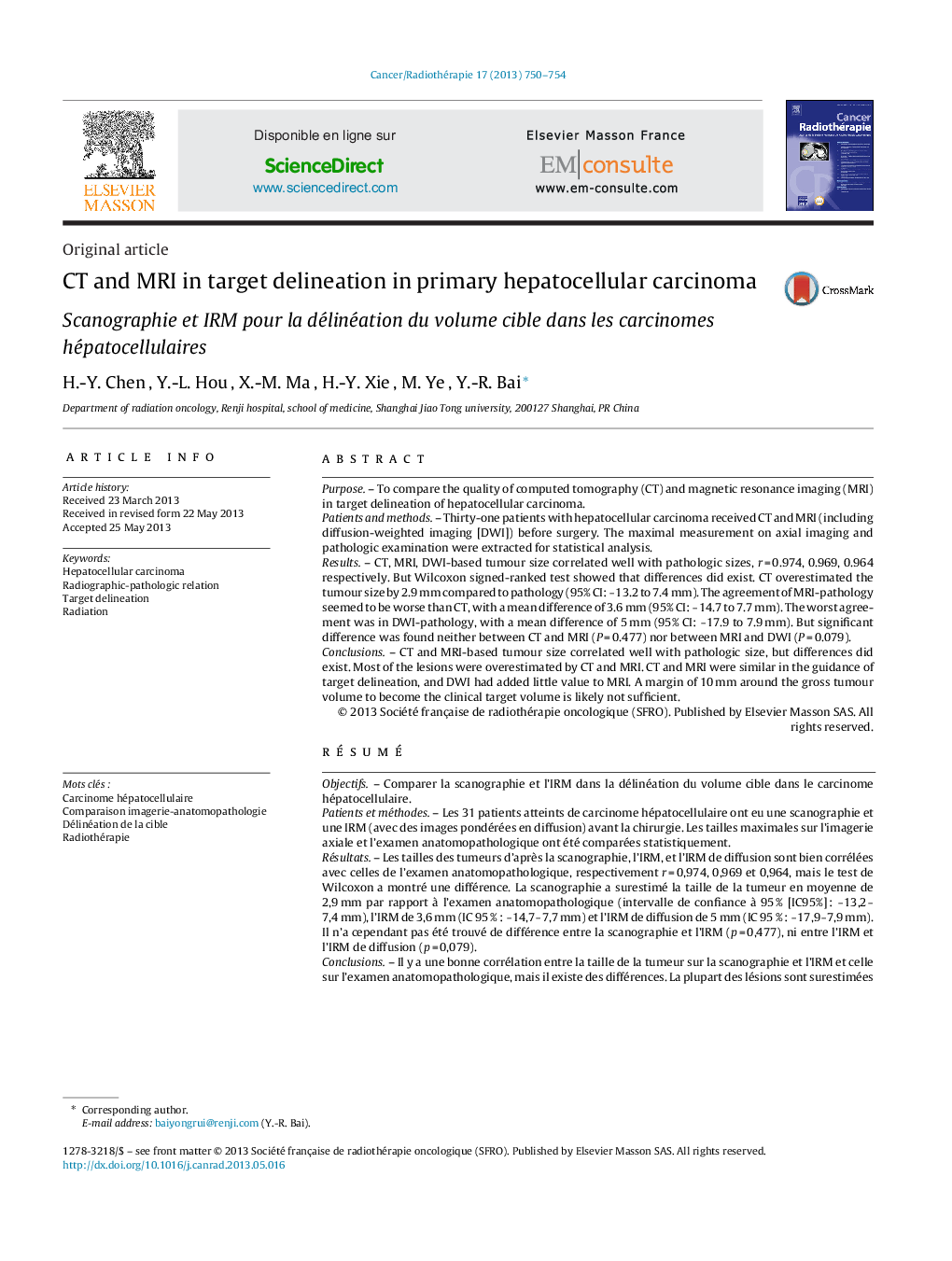| کد مقاله | کد نشریه | سال انتشار | مقاله انگلیسی | نسخه تمام متن |
|---|---|---|---|---|
| 2117812 | 1085213 | 2013 | 5 صفحه PDF | دانلود رایگان |

PurposeTo compare the quality of computed tomography (CT) and magnetic resonance imaging (MRI) in target delineation of hepatocellular carcinoma.Patients and methodsThirty-one patients with hepatocellular carcinoma received CT and MRI (including diffusion-weighted imaging [DWI]) before surgery. The maximal measurement on axial imaging and pathologic examination were extracted for statistical analysis.ResultsCT, MRI, DWI-based tumour size correlated well with pathologic sizes, r = 0.974, 0.969, 0.964 respectively. But Wilcoxon signed-ranked test showed that differences did exist. CT overestimated the tumour size by 2.9 mm compared to pathology (95% CI: -13.2 to 7.4 mm). The agreement of MRI-pathology seemed to be worse than CT, with a mean difference of 3.6 mm (95% CI: -14.7 to 7.7 mm). The worst agreement was in DWI-pathology, with a mean difference of 5 mm (95% CI: -17.9 to 7.9 mm). But significant difference was found neither between CT and MRI (P = 0.477) nor between MRI and DWI (P = 0.079).ConclusionsCT and MRI-based tumour size correlated well with pathologic size, but differences did exist. Most of the lesions were overestimated by CT and MRI. CT and MRI were similar in the guidance of target delineation, and DWI had added little value to MRI. A margin of 10 mm around the gross tumour volume to become the clinical target volume is likely not sufficient.
RésuméObjectifsComparer la scanographie et l’IRM dans la délinéation du volume cible dans le carcinome hépatocellulaire.Patients et méthodesLes 31 patients atteints de carcinome hépatocellulaire ont eu une scanographie et une IRM (avec des images pondérées en diffusion) avant la chirurgie. Les tailles maximales sur l’imagerie axiale et l’examen anatomopathologique ont été comparées statistiquement.RésultatsLes tailles des tumeurs d’après la scanographie, l’IRM, et l’IRM de diffusion sont bien corrélées avec celles de l’examen anatomopathologique, respectivement r = 0,974, 0,969 et 0,964, mais le test de Wilcoxon a montré une différence. La scanographie a surestimé la taille de la tumeur en moyenne de 2,9 mm par rapport à l’examen anatomopathologique (intervalle de confiance à 95 % [IC95%] : -13,2-7,4 mm), l’IRM de 3,6 mm (IC 95 % : -14,7-7,7 mm) et l’IRM de diffusion de 5 mm (IC 95 % : -17,9-7,9 mm). Il n’a cependant pas été trouvé de différence entre la scanographie et l’IRM (p = 0,477), ni entre l’IRM et l’IRM de diffusion (p = 0,079).ConclusionsIl y a une bonne corrélation entre la taille de la tumeur sur la scanographie et l’IRM et celle sur l’examen anatomopathologique, mais il existe des différences. La plupart des lésions sont surestimées par la scanographie et l’IRM. La scanographie et l’IRM se sont avérées similaires dans la délinéation de la cible, et l’IRM de diffusion a eu peu d’intérêt. Une marge de 10 mm entre volume tumoral macroscopique et le volume cible anatomoclinique n’est probablement pas suffisante.
Journal: Cancer/Radiothérapie - Volume 17, Issue 8, December 2013, Pages 750–754